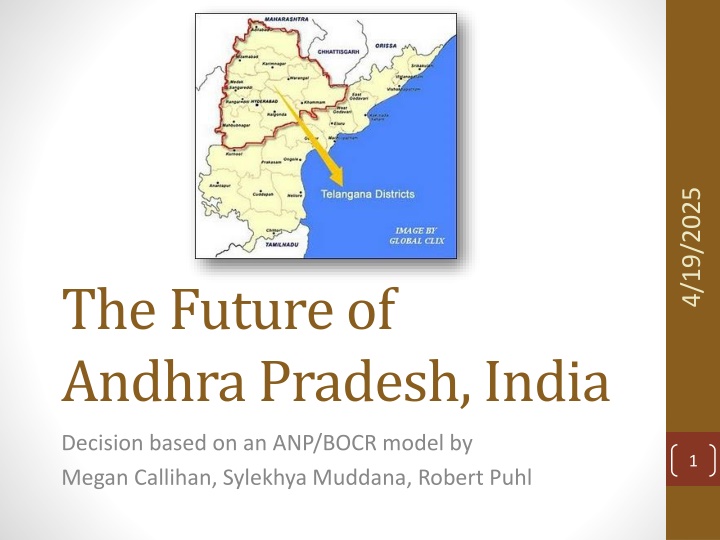
Future Decision-Making in Andhra Pradesh, India
Explore a futuristic decision-making model for Andhra Pradesh, India, focusing on the demand for Telangana statehood and potential alternatives. Follow the analysis by Megan Callihan, Sylekhya Muddana, and Robert Puhl through a structured approach of modeling, sensitivity analysis, and key findings. Discover the complexities surrounding state bifurcation and the implications for the region's development.
Download Presentation

Please find below an Image/Link to download the presentation.
The content on the website is provided AS IS for your information and personal use only. It may not be sold, licensed, or shared on other websites without obtaining consent from the author. If you encounter any issues during the download, it is possible that the publisher has removed the file from their server.
You are allowed to download the files provided on this website for personal or commercial use, subject to the condition that they are used lawfully. All files are the property of their respective owners.
The content on the website is provided AS IS for your information and personal use only. It may not be sold, licensed, or shared on other websites without obtaining consent from the author.
E N D
Presentation Transcript
4/19/2025 The Future of Andhra Pradesh, India Decision based on an ANP/BOCR model by Megan Callihan, Sylekhya Muddana, Robert Puhl 1
Agenda 1.Introduction 2.Modeling the Future 3.Sensitivity Analysis 4.Findings 2 4/19/2025 Megan Callihan, Sylekhya Muddana, Robert Puhl
1. Introduction Demand for Telangana is one of the oldest concerns for a separate state in India. In 1956, Telangana was merged with the Andhra state to form Andhra Pradesh, against the wishes of Telangana people. Statehood s proponents argue that Telangana hasn t received state development assistance proportional to its size. Hyderabad, the capital city, geographically within the proposed new state, but claimed by both sides. The central government postponed a decision to bifurcate the southern state following violent protests both for and against. 3 4/19/2025 Megan Callihan, Sylekhya Muddana, Robert Puhl
1.1 Alternatives Do not split the State. Do not split the State, but create a Development Committee for the betterment of the Telangana Region. Split the State, keeping Hyderabad as the capital of Telangana and develop a new capital for Andhra. Spilt the State and convert Hyderabad into a Union Territory. 4 4/19/2025 Megan Callihan, Sylekhya Muddana, Robert Puhl
1.2 In the News (BBC) 5 4/19/2025 Megan Callihan, Sylekhya Muddana, Robert Puhl
2. Modeling the future Outlining the overall structure: 6 4/19/2025 Megan Callihan, Sylekhya Muddana, Robert Puhl
2.1 The Benefits Model 7 4/19/2025 Megan Callihan, Sylekhya Muddana, Robert Puhl
2.1 The Opportunities Model 8 4/19/2025 Megan Callihan, Sylekhya Muddana, Robert Puhl
2.1 The Costs Model 9 4/19/2025 Megan Callihan, Sylekhya Muddana, Robert Puhl
2.1 The Risks model 10 4/19/2025 Megan Callihan, Sylekhya Muddana, Robert Puhl
2.2 Determination of subnets Applying the top 70% rule after the pairwise comparison, we get for benefits: PrioritiesNormalized Merits Criteria Subcriteria Priorities 0.03666 0.00785 0.01957 0.00605 0.42862 0.05569 0.02763 0.09241 0.02054 0.02233 0.23863 0.04401 Benefits 0.1131 Political 0.0701 Increase in Security Decrease in Corruption Improvement in public works Increase in Taxes Employment Infrastructure Higher Real estate value Increased labor quality Social classes Reputation Social systems Historical significance 0.01833 0.003923 0.009787 0.003025 0.214311 0.027847 0.013815 0.046206 0.010269 0.011165 0.119315 0.022007 Economic 0.6044 Cultural 0.3255 11 Total Benefits: 0.5 67% 4/19/2025 Megan Callihan, Sylekhya Muddana, Robert Puhl
2.2 Determination of subnets Applying the top 70% rule after the pairwise comparison, we get for opportunities: PrioritiesNormalized Merits Criteria Subcriteria Priorities 0.00992 0.01349 0.03458 0.01702 0.03937 0.19765 0.02545 0.01607 0.07419 0.02891 0.45736 0.08599 Opportunities Political 0.2699 Long term security Anti-corruption Public works enhancement Taxnet Increase Support to local businesses Foreign Direct Investment increase Employment generation Infrastructure Population distribution Local affiliation Upward mobility Social systems 0.004962 0.006744 0.017292 0.008508 0.019684 0.098825 0.012727 0.008036 0.037096 0.014453 0.228678 0.042994 0.075 Economic 0.2785 Cultural 0.6464 12 Total Opportunities: 0.5 73% 4/19/2025 Megan Callihan, Sylekhya Muddana, Robert Puhl
2.2 Determination of subnets Applying the top 70% rule after the pairwise comparison, we get for costs: PrioritiesNormalized Merits Criteria Subcriteria Priorities 0.09262 0.06744 0.03340 0.47594 0.03659 0.01662 0.00985 0.02487 0.16623 0.03019 0.02012 0.02610 Costs 0.3525 Political 0.6694 Violance Cost of corruption Reduction in taxes Election spending Infrastructure development Reduction in FDI Unemployment Costs to Business Social instability Stagnation Poverty Illiteracy 0.046311 0.033722 0.016701 0.237972 0.018297 0.008311 0.004927 0.012437 0.083115 0.015097 0.010061 0.013049 Economic 0.0879 Cultural 0.2426 13 Total Costs: 0.5 73% 4/19/2025 Megan Callihan, Sylekhya Muddana, Robert Puhl
2.2 Determination of subnets Applying the top 70% rule after the pairwise comparison, we get for risks: PrioritiesNormalized Merits Criteria Subcriteria Priorities 0.42484 0.03445 0.06040 0.07204 0.00732 0.02707 0.02389 0.01678 0.02043 0.24334 0.02043 0.04901 Risks 0.2645 Political 0.5917 Government Instability Budget gap Increase in corruption Increase in crime Trade barriers Inflation Reduced labor supply Purchasing power Cultural Isolation Societal imbalances Psychological divide Increase in poverty 0.212419 0.017225 0.030198 0.036022 0.003658 0.013533 0.011945 0.008392 0.010217 0.121671 0.010217 0.024503 Economic 0.0751 Cultural 0.3332 14 Total Risks: 0.5 67% 4/19/2025 Megan Callihan, Sylekhya Muddana, Robert Puhl
2.3 Building of Subnets 15 4/19/2025 Megan Callihan, Sylekhya Muddana, Robert Puhl
2.4 The Ratings Model 16 4/19/2025 Megan Callihan, Sylekhya Muddana, Robert Puhl
3. Sensitivity Analysis Benefits Opportunities 17 4/19/2025 Megan Callihan, Sylekhya Muddana, Robert Puhl
3. Sensitivity Analysis Costs Risks 18 4/19/2025 Megan Callihan, Sylekhya Muddana, Robert Puhl
4. Findings BOCR Results: Additive Benefits Opportunities Costs Risks 19 4/19/2025 Megan Callihan, Sylekhya Muddana, Robert Puhl
4. Findings BOCR Results: Multiplicative Benefits Opportunities Costs Risks 20 4/19/2025 Megan Callihan, Sylekhya Muddana, Robert Puhl
4. Overall Findings Additive (Negative) Multiplicative Result: No Split but Form Development Committee (Alternative 2) Result: No Split but Form Development Committee (Alternative 2) 21 4/19/2025 Megan Callihan, Sylekhya Muddana, Robert Puhl
Questions? 22 4/19/2025 Megan Callihan, Sylekhya Muddana, Robert Puhl
